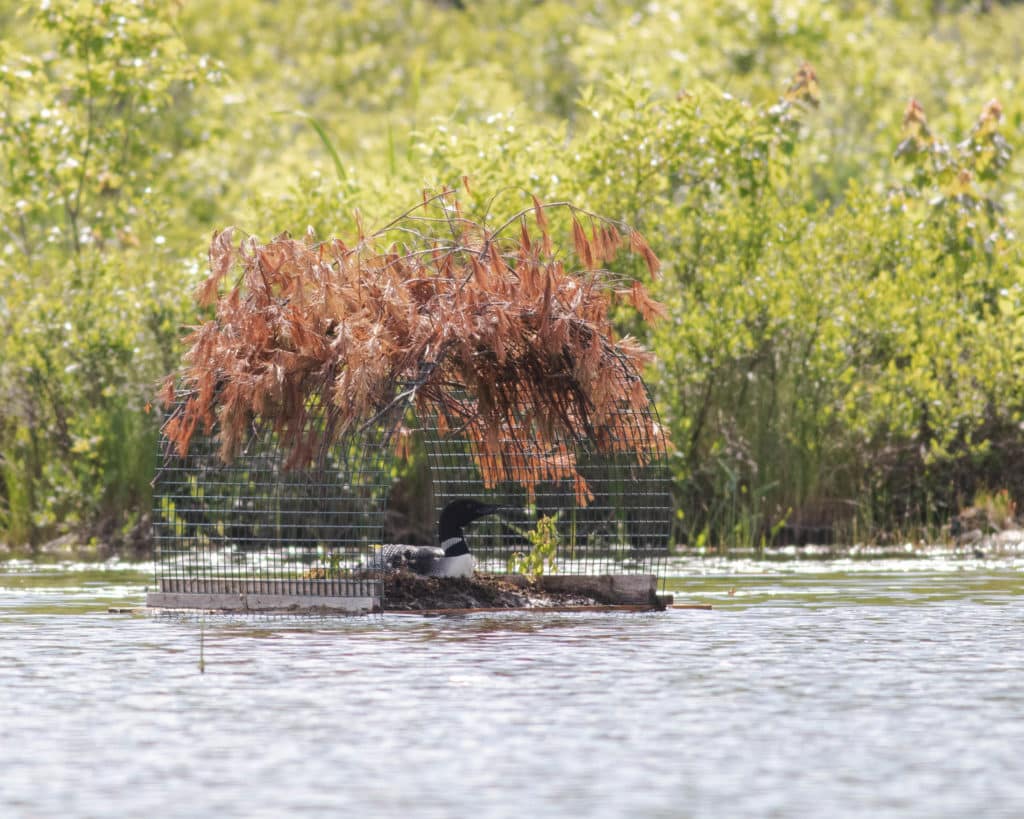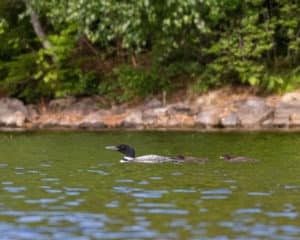
It’s always exciting when a loon chick hatches, but this summer we’re more excited than ever to announce that a loon chick has hatched on an artificial nesting platform! As part of the new Maine Loon Restoration Project, Maine Audubon has worked with volunteers to put out 13 loon rafts this year. We’re thrilled to have loons nesting on the rafts already, because it can often take several years for loon pairs to get used to a nesting raft in their territory and take to it as a new site.
Out of these 13 loon rafts, six are being used as nesting locations so far and five chicks have hatched to date! Additional loon rafts are also being placed by our partners in the Loon Restoration Project—Maine Lakes, Lakes Environmental Association, and the Penobscot Nation—with the help and dedication of lake associations and local residents.

All told, the project partners are hoping to place 100 nesting platforms on lakes and ponds in an eleven-county region through 2026. We only deploy these rafts in areas where loon pairs have failed to hatch chicks year after year, and only when the reason for nesting failure has to do with water level management, land predators, lack of good natural nesting habitat, or when the pair’s natural nest is in a high-risk location such as right on a public beach or on an island boat landing.
We’re extremely judicious about this, because a raft put out for any other reason, or put in a place where loons are already productive, can actually be counterproductive and hurt a pair’s chances of hatching chicks. Here are some of the reasons why: If you put an artificial raft too close to the edge of a pair’s breeding territory, it can invite dangerous and exhausting territorial conflicts as the competing pairs try to defend their territory boundaries. Territorial fights in loons can be fatal. And things can and do go wrong with rafts. They can break loose, catch a chick’s foot, or sink and flood the nest. A good rule of thumb: If a pair hatches a chick at least once every three years, they don’t need an artificial raft.
However, if a pair has trouble nesting, artificial loon nesting platforms can increase their productivity and are a very important conservation tool. For some of the pairs using the rafts, it may be the first time they’ve hatched chicks in years.
We are using two basic raft designs, one made from cedar logs and a more modular design made from trap wire and other eco-friendly components. As Laura Robinson, a designer of the modular rafts, says, “An important thing to understand about the rafts is that they are not birdhouses. It would be very dangerous to put a loon raft in a territory without studying it. So while we make our rafts available to conservation groups, we don’t make them available to the general public because of the studying that needs to be done.”
We’re hoping for even more success next year. We noticed some loon pairs scoping out the rafts we placed, though they ultimately chose to nest at other locations. Many of those nests are now failing for the same old reasons. We hope with these artificial rafts right nearby that the loons either make a second nesting attempt this year or try them out next year. This has already happened on one pond this year and the pair is now nesting on one of our rafts after failing to hatch eggs on their prior nest located on a stump.
If you know of a loon pair that you think might benefit from a raft, please email any of the project partners. To find out more about when rafts are appropriate and how the program works, please take a look at our loon raft information packet or check out the Loon Restoration Project webpage.
Contact information:
Maine Audubon, loonrestoration@maineaudubon.org
Maine Lakes, dmorris@lakes.me, lakes.me/loons
Lakes Environmental Association, maggie@leamaine.org, mainelakes.org
This project is funded by the U.S. Fish and Wildlife Service on behalf of the Bouchard Barge 120 Buzzards Bay Oil Spill Trustees.
